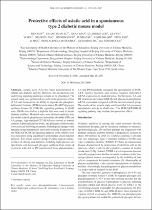| dc.contributor.author | Sun, Wen | |
| dc.contributor.author | Xu, Guangyuan | |
| dc.contributor.author | Matsabisa, Motlalepula | |
| dc.date.accessioned | 2023-06-07T10:07:36Z | |
| dc.date.available | 2023-06-07T10:07:36Z | |
| dc.date.issued | 2017 | |
| dc.identifier.citation | Sun, W. et al. (2017). Protective effects of asiatic acid in a spontaneous type 2 diabetic mouse model. Molecular Medicine Reports, 16 (2) ,1333-1339. https://doi.org/10.3892/mmr.2017.6684 | en_US |
| dc.identifier.issn | 1791-3004 | |
| dc.identifier.uri | https://doi.org/10.3892/mmr.2017.6684 | |
| dc.identifier.uri | http://hdl.handle.net/10566/9060 | |
| dc.description.abstract | Asiatic acid (AA) has been demonstrated to exhibit anti‑diabetic activity. However, the mechanisms and underlying signaling pathways remain to be elucidated. The present study was performed to confirm the protective effect of AA and demonstrate its ability to regulate the phosphatidylinositol 3‑kinase (PI3K)/protein kinase B (AKT)/glycogen synthase kinase‑3β (GSK‑3β) signaling pathway in db/db mice. Db/db mice fed on a high‑fat diet were used to model diabetes mellitus. Modeled mice were divided randomly into the model control, pioglitazone hydrochloride tablet (PH) and AA groups. Age‑matched C57 BL/6J mice served as normal controls. | en_US |
| dc.language.iso | en | en_US |
| dc.publisher | Spandidos Publications | en_US |
| dc.subject | Medical science | en_US |
| dc.subject | Medicinal plants | en_US |
| dc.subject | Asiatic acid | en_US |
| dc.subject | Herbal medicine | en_US |
| dc.title | Protective effects of asiatic acid in a spontaneous type 2 diabetic mouse model | en_US |
| dc.type | Article | en_US |

